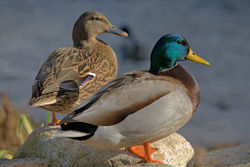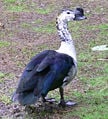What Is Duck? Animal Or Bird ?
| Ducks | ||||||||||
|---|---|---|---|---|---|---|---|---|---|---|
 A duck (female person) and drake (male) Mallard | ||||||||||
| Scientific classification | ||||||||||
| ||||||||||
| | ||||||||||
|
Duck is the common name for any member of a variety of species of relatively brusque-necked, large-billed waterfowl in the Anatidae family of birds, and particularly those in the subfamily Anatinae ("truthful ducks"). The Anatidae family too includes swans, which are larger and have a longer neck than ducks, and geese, which generally are larger and with a less pointed bill.
Ducks are more often than not aquatic birds and may exist establish in both freshwater and marine environments. There are both wild and domestic groups.
The term "duck" sometimes is specifically for adult females and "drake" for adult males. Some employ the terms "hen" and "drake," respectively.
Across their own individual purpose of survival, maintenance, and reproduction, ducks as a group offer numerous ecological, economic, aesthetic, and recreational benefits. They are integral to ecosystem food bondage, are farmed for their feathers, eggs, and meat, are appreciated for their beauty of form, activeness, and color, and are a popular focus of recreational hunters.
Ducks are sometimes confused with several types of unrelated water birds with similar forms, such as loons or defined, grebes, gallinules, and coots.
Etymology
The discussion duck (from Anglo-Saxon dūce), meaning the bird, came from the verb "to duck" (from Anglo-Saxon supposed *dūcan) significant "to bend down low as if to go nether something" or "to swoop," considering of the way many species in the dabbling duck group feed past upending (compare the Dutch discussion duiken = "to dive").
This happened because the older Onetime English language discussion for "duck" came to be pronounced the aforementioned as the word for "cease"—other Germanic languages still take like words for "duck" and "end," for example, Dutch eend = "duck," eind = "end," German language ente = "duck," and ende = "stop." This similarity goes back to Indo-European—compare Latin anas (stem anat-) = "duck," Lithuanian antis = "duck," Ancient Greek νησσα, νηττα (nessa, netta) = "duck" and Sanskrit anta = "end."
Description
Like other Anatidae, ducks have a broad trunk, partially webbed anxiety, a somewhat flattened beak with horny lamellae (miniature ridges, like the "teeth of a comb"), and a hard process (the "smash") at the tip of the bill, besides as a large preen gland crowned by a tuft of feathers (Hutchins 2003). Anatidae are excellent at shedding water due to special oils. Ducks all take webs between their front toes.
Most ducks have a wide flat beak adapted for dredging. They exploit a variety of food sources such as grasses, aquatic plants, fish, insects, small amphibians, worms, and modest mollusks.
Ducks are more often than not divided into iii main groups. The diving ducks and sea ducks, such as the canvasback, are found on rivers and lakes and fodder deep underwater. Surface feeders, or dabbling ducks, such as the mallard and wood duck, are mutual in ponds and marshes and feed on the surface of water or on land. The lamellae of dabbling ducks are similar to a whale'southward baleen, with these tiny rows of plates along the inside of the beak letting them filter water out of the side of their beaks and keep nutrient within (Ogden 2003). To be able to submerge more easily, the diving ducks are heavier than dabbling ducks, and therefore take a longer time in taking off to fly, whereas the dabbling ducks can take straight off. There are also fish-eating ducks, such as the mergansers, smew, and goosnader that are adapted to catch large fish and prefer open water.
Males of all Anatidae, including the ducks, have a copulatory organ that is evaginated from the cloaca for copulation (Hutchins 2003). Anatidae are remarkable for existence 1 of the few families of birds that possess a penis. Still, the sperm do not flow through a central canal, as in mammals, just rather forth grooves on the outside (Hutchins 2003).
Near ducks are monogamous. Withal, unlike true geese, which more often than not stay paired for several seasons, most ducks are seasonally monogamous, with pair bonds lasting only until midincubation or hatching of the immature (Hutchins 2003).
The males (drakes) of northern species oft have improvident feather, just that is molted in summer to requite a more female-similar appearance, the "eclipse" feather. Southern resident species typically show less sexual dimorphism.
Like the geese, the flight feathers of ducks are molted just one time a year, and are lost simultaneously so that flying is non possible for that short flow of time (Hutchins 2003). All the same, almost truthful ducks exercise molt other feathers (the profile feathers) twice a year (Hutchins 2003). When ducks are in a flightless stage, they generally seek out protected habitat with good food supplies during this period. This molt typically precedes migration.
Some duck species, mainly those convenance in the temperate and arctic Northern Hemisphere, are migratory, merely others, particularly in the tropics, are not. Some ducks, particularly in Australia where rainfall is patchy and erratic, are nomadic, seeking out the temporary lakes and pools that course after localized heavy rain.
Despite widespread misconceptions, most ducks other than female person mallards and domestic ducks exercise non "quack." A mutual false urban fable says that quacks do not echo (Amos 2003).
Taxonomy
Truthful ducks are members of the subfamily Anatinae of the family Anatidae. Other groups with the name duck are as well located in several other subfamilies within Anatidae. The following places the ducks in the context of the order Anseriformes.
Society ANSERIFORMES
- Family Anhimidae: screamers
- Family Anseranatidae: the Magpie-goose
- Family Anatidae
- Subfamily Dendrocygninae: Whistling ducks (sometimes given full family status as the Dendrocygnidae).
- Subfamily Thalassorninae: the White-backed Duck.
- Subfamily Anserinae: Swans and geese.
- Subfamily Stictonettinae: the Freckled Duck.
- Subfamily Plectropterinae: the Spur-winged Goose.
- Subfamily Tadorninae: Shelducks and sheldgeese - probably paraphyletic
- Subfamily Anatinae: Dabbling ducks and moa-nalos
- Subfamily Aythyinae: Diving ducks (sometimes included in Anatinae)
- Subfamily Merginae: eiders, scoters, mergansers and other sea-ducks.
- Subfamily Oxyurinae: Potent-tailed ducks and allies.
- Family unit Dromornithidae (fossil): mihirungs
- Family Presbyornithidae (fossil): several genera of wading-"geese," including the oldest known anseriform, Vegavis.
Predators
A worldwide group similar the ducks has many predators. Ducklings are particularly vulnerable, since their inability to fly makes them like shooting fish in a barrel prey non only for avian predators, simply besides big fish like superhighway, crocodilians, and other aquatic hunters, including fish-eating birds such equally herons. Nests may also be raided past land-based predators, and brooding females may sometimes exist defenseless unaware on the nest past mammals (eastward.g. foxes) and large birds, including hawks and eagles.
Developed ducks are fast fliers, but may be caught on the water by large aquatic predators. This tin can occasionally include fish such as the muskie in North America or the pike in Europe. In flight, ducks are condom from all but a few predators such as humans and the Peregrine Falcon, which regularly uses its speed and force to grab ducks.
Ducks and humans
Ducks have many economical uses, being farmed for their meat, eggs, and feathers. Duck is considered a delicacy in a number of cultures.
Foie gras (French for "fat liver") is the liver of a duck (or goose) that has been specially fattened. Foie gras is one of the most pop delicacies in French cuisine and its flavour is described equally rich, buttery, and delicate, unlike that of a regular duck (or goose) liver. The technique dates equally far back as 2500 B.C.E., when the aboriginal Egyptians began keeping birds for food and deliberately fattened the birds through force-feeding. Today, France is by far the largest producer and consumer of foie gras, though information technology is produced and consumed worldwide, particularly in other European nations and the United states.
Confit de canard involves duck being diminished in herbs and salt, cooked in savory broth or fat, and then preserved in rendered fat. Such confits are a specialty of the southwest of French republic (Toulouse, Dordogne, etc.) and are used in refined versions of dishes such as cassoulet. Although confit of duck or goose are now considered somewhat luxurious products, these dishes were used by peasants as a means to store meats for periods of time without refrigeration.
Ducks are kept and bred by aviculturists and often displayed in zoos. All domestic ducks are descended from the wild mallard Anas platyrhynchos, except muscovy ducks (DUC 2021). Many domestic breeds have become much larger than their wild ancestor, with a "hull length" (from base of neck to base of tail) of 30 cm (12 inches) or more and routinely able to swallow an adult British common frog, Rana temporaria, whole.
In many areas, wild ducks of diverse species (including ducks farmed and released into the wild) are hunted for food or sport, past shooting, sometimes by using decoys. From this came the expression "a sitting duck," which ways "an like shooting fish in a barrel target."
Ducks have become an accepted presence in populated areas. Migration patterns accept changed such that many species remain in an surface area during the wintertime months. Bound and early on summer months detect ducks influencing human activity through their nesting. It is not uncommon for a duck pair to nest well away from h2o needing a long expedition to water for the hatchlings—this sometimes causes an urgent wildlife rescue operation if the duck nested somewhere unsuitable like in a pocket-size enclosed courtyard.
The expression "quacks like a duck" is sometimes a curt grade for "It looks like a duck, it quacks like a duck, information technology swims like a duck, and so it's a duck.," used as proverbial to counter abstruse arguments that something is not what it appears to be.
Gallery
-

A duck stretching its wings in a freshwater bound
-
A domesticated duck
-
Some domesticated ducks
-

A female mallard with a duckling mallard
-

African comb duck
-

Mallard drake
-

Ruddy shelduck - not a true duck but a member of the Tadorninae
-

Male person wood duck in eclipse plumage
-

Female person mallard
-

Female mallard with ducklings
-

Male muscovy duck
-

Mandarin duck
-
Ducks in a pond
-

Indian runner duck
-

Ringed Teal
-

Blood-red-crested pochard
References
ISBN links support NWE through referral fees
- Amos, J. 2003. Audio science is quakers BBC News. Retrieved March four, 2021.
- Ducks Unlimited Canada (DUC). 2021. Mallard Ducks Unlimited Canada. Retrieved March 4, 2021.
- Hutchins, Michael (ed.). 2003. Grzimek's Animate being Life Encyclopedia: Lower Metazoans and Lesser Deuterostomes. Detroit: Thomson-Gale. ISBN 0787657778
- Ogden, E. 2003. Dabbling ducks Heart for Wildlife Ecology. Retrieved March 4, 2021.
External links
All links retrieved March 4, 2021.
- Ducks Unlimited Conservation
- Ducks Gateway to poultry production and products, FAO.
- The Mallard (Anas platyrhynchos) – The Wide-Billed Duck
- The Muscovy Duck – A Strange And Noisy "Masked" Duck
Credits
New Globe Encyclopedia writers and editors rewrote and completed the Wikipedia commodity in accord with New World Encyclopedia standards. This commodity abides past terms of the Creative Commons CC-by-sa iii.0 License (CC-past-sa), which may exist used and disseminated with proper attribution. Credit is due under the terms of this license that can reference both the New World Encyclopedia contributors and the selfless volunteer contributors of the Wikimedia Foundation. To cite this article click hither for a list of acceptable citing formats.The history of before contributions by wikipedians is accessible to researchers hither:
- Duck history
- Anseriformes history
- Foie_gras history
- Confit history
The history of this commodity since it was imported to New Earth Encyclopedia:
- History of "Duck"
Note: Some restrictions may apply to use of individual images which are separately licensed.
Source: https://www.newworldencyclopedia.org/entry/Duck
Posted by: edwardshimpat.blogspot.com




0 Response to "What Is Duck? Animal Or Bird ?"
Post a Comment